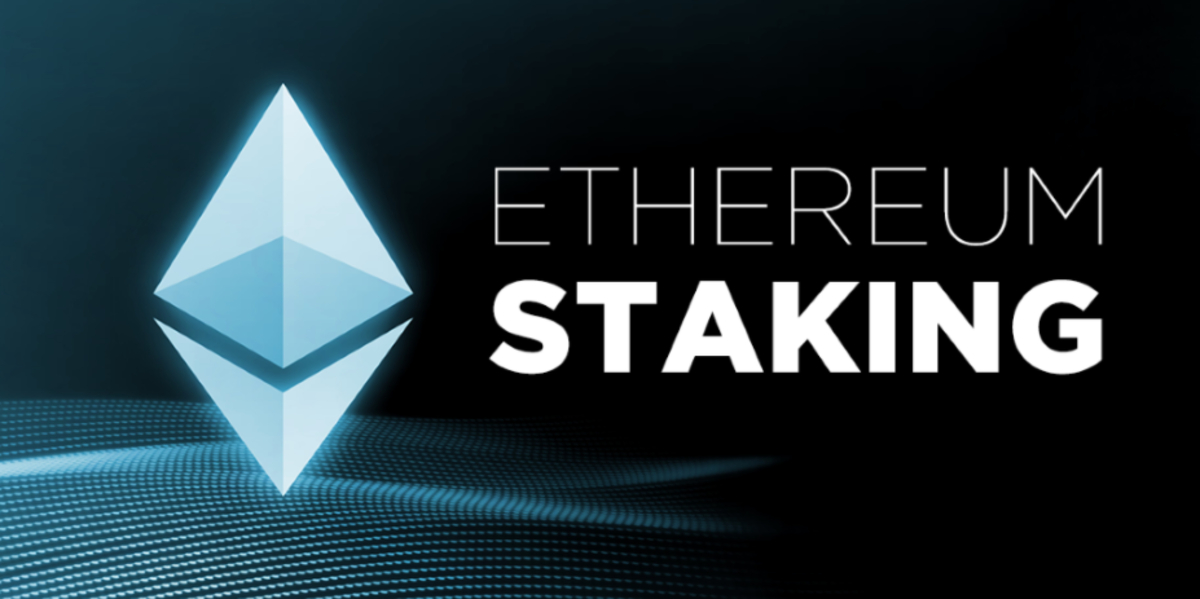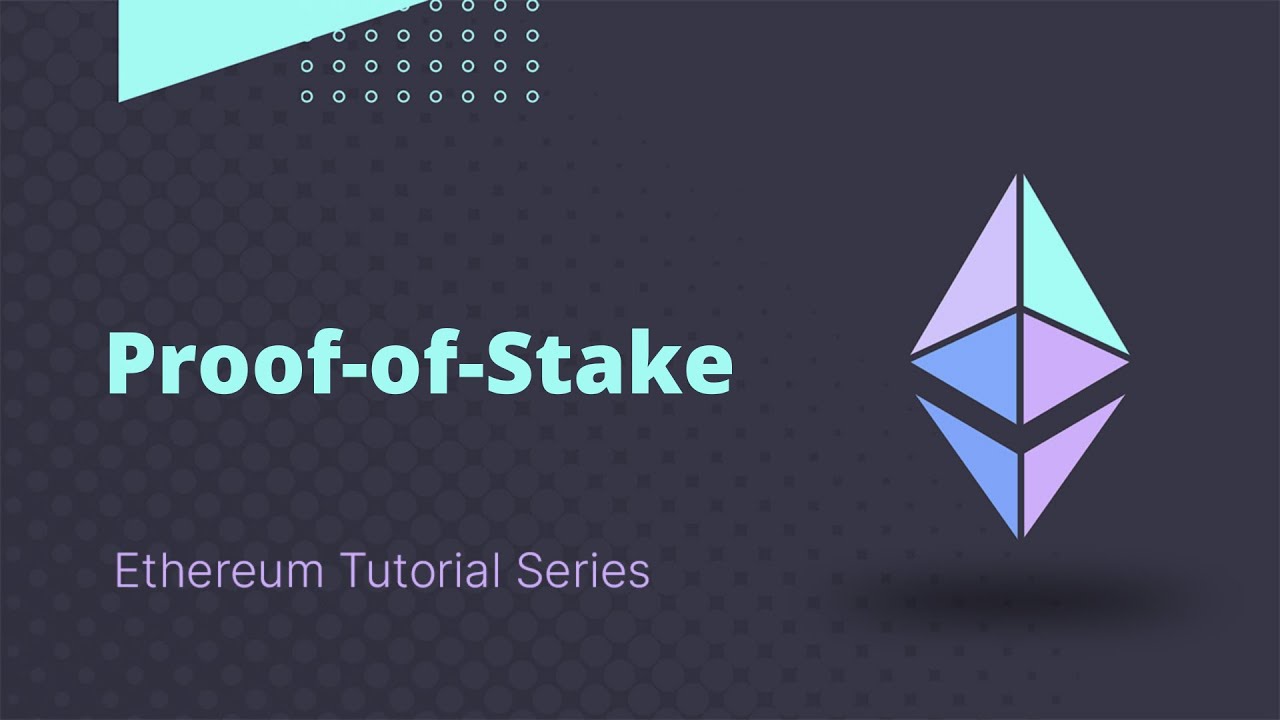Introduction
Welcome to the world of Ethereum staking! As the popularity of cryptocurrencies continues to soar, Ethereum has emerged as one of the leading digital currencies in the market. Ethereum staking has gained significant attention among crypto enthusiasts due to its potential for passive income generation and its role in securing the Ethereum blockchain.
So, what exactly is Ethereum staking? In simple terms, it involves holding and locking up a certain amount of Ethereum in a wallet to support the network’s operations. In return, stakers are rewarded with additional Ethereum tokens as an incentive for maintaining the network’s security and integrity.
Why stake Ethereum? Well, aside from the potential for earning rewards, staking Ethereum offers several benefits. Firstly, it allows you to actively participate in the network and contribute to its maintenance and consensus. By staking your Ethereum, you become a validator, verifying transactions and securing the network against potential attacks.
Secondly, staking Ethereum provides an opportunity for long-term investment. Ethereum has shown immense growth potential, and staking allows you to directly benefit from this growth. Instead of simply holding your Ethereum in a wallet, staking enables you to earn additional coins while contributing to the overall stability and security of the network.
Now that we understand the fundamentals of Ethereum staking, let’s explore how it actually works. Staking Ethereum involves locking up your coins and delegating them to a validator. Validators are responsible for creating new blocks, validating transactions, and maintaining the network’s consensus. By delegating your Ethereum to a validator, you can passively earn rewards based on the amount you stake.
Before getting started with Ethereum staking, there are a few requirements you need to fulfill. First and foremost, you will need to have a certain amount of Ethereum to stake. The specific minimum requirement may vary depending on the network and staking provider you choose. Additionally, you will need an Ethereum wallet to store your coins. There are several wallets available, ranging from hardware wallets to software wallets, that you can choose from based on your preferences and security needs.
Choosing the right staking provider is crucial as well. Different providers offer varying rewards, fees, and features. It’s important to do thorough research and consider factors such as reputation, reliability, and customer support before selecting a staking provider.
In the next sections, we will dive deeper into the process of setting up an Ethereum wallet, transferring your Ethereum to the staking provider, delegating your Ethereum to a validator, and monitoring and managing your staking activities. We will also discuss the potential rewards and returns you can expect from Ethereum staking, as well as the risks and considerations involved.
What is Ethereum Staking?
Ethereum staking is a process that involves securing and validating transactions on the Ethereum blockchain by holding and locking up a certain amount of Ethereum, known as a stake. Stakers, also referred to as validators, participate in the consensus mechanism of Ethereum’s proof-of-stake (PoS) protocol, replacing the traditional proof-of-work (PoW) consensus used by cryptocurrencies like Bitcoin.
Under the PoS model, validators are chosen to create new blocks and validate transactions based on the amount of Ethereum they have staked. The more Ethereum a validator stakes, the higher their chances of being chosen to create blocks and earn rewards.
One of the main goals of Ethereum staking is to enhance the network’s security while reducing energy consumption. Unlike PoW, which relies on miners solving complex mathematical puzzles to validate transactions, PoS requires validators to prove their ownership of a certain stake in Ethereum. Validators are motivated to act honestly and in the best interest of the network, as their stakes can be slashed if they attempt any malicious activity.
By staking Ethereum, you actively participate in maintaining the network’s security and consensus. When validators create new blocks, they include transactions and verify their legitimacy. This process ensures that transactions on the Ethereum blockchain are valid, secure, and resistant to censorship and tampering.
Additionally, Ethereum staking allows you to earn passive income in the form of rewards. Validators receive rewards in proportion to the amount of Ethereum they have staked. These rewards are typically paid out in additional Ethereum tokens, encouraging validators to continue supporting the network. The exact reward structure may vary depending on the Ethereum protocol and the staking platform or service you use.
It’s important to note that staking Ethereum does come with certain risks. Validators are required to maintain a stable internet connection and keep their nodes running continuously to be eligible for rewards. Failure to do so may result in missed rewards or potential penalties. Additionally, stakers must be cautious of potential security risks associated with storing and managing their Ethereum, including the risk of theft or loss.
Ethereum staking has become an attractive option for cryptocurrency investors and enthusiasts looking to earn passive income and actively participate in the network. It offers the opportunity to contribute to the growth and security of Ethereum while potentially reaping the benefits of its increasing value.
Now that you understand what Ethereum staking is, let’s explore the process of how it works and the requirements involved in greater detail.
Why Stake Ethereum?
Staking Ethereum offers a multitude of benefits that make it an appealing option for crypto enthusiasts. Let’s explore some of the key reasons why you should consider staking Ethereum.
Firstly, staking Ethereum allows you to earn passive income. By staking your Ethereum holdings, you become a validator on the network and contribute to the security and consensus of the blockchain. In return, you are rewarded with additional Ethereum tokens. This process is often referred to as “earning interest” on your holdings, as your staked Ethereum generates returns over time. Depending on the protocol and staking platform you use, the rewards can range from a few percent to potentially double-digit annual returns.
Secondly, staking Ethereum gives you the opportunity to actively participate in network governance. As a validator, you play a vital role in the decision-making process for protocol upgrades, voting on proposals, and ensuring the network’s stability. This involvement allows stakers to have a say in the future direction of Ethereum and contribute to its growth and development.
Another reason to stake Ethereum is the potential for asset appreciation. Ethereum has demonstrated its ability to appreciate in value over time, and staking allows you to benefit from this growth. By staking your Ethereum tokens rather than keeping them idle, you have a chance to earn additional tokens, which can increase your overall Ethereum holdings and potential profits.
Staking Ethereum also promotes network security. As validators play a crucial role in maintaining the network’s integrity, their active participation leads to a more robust and secure ecosystem. Thus, by staking Ethereum, you contribute to the long-term stability and resilience of the blockchain, making it less susceptible to attacks and ensuring the trustworthiness of the network.
Besides the financial and security benefits, staking Ethereum can also provide a sense of community and participation within the crypto space. By joining the ranks of validators, you become part of a global network of Ethereum enthusiasts who share a common interest in the success and growth of the platform. This sense of belonging and engagement can be rewarding on a personal level, creating connections and fostering collaboration with others who have similar passions.
Ultimately, staking Ethereum presents a unique opportunity to earn passive income, actively contribute to the Ethereum network, and potentially benefit from the growth of the ecosystem. However, it’s important to consider the potential risks and do thorough research before diving into the world of staking. Understanding the process, requirements, and potential returns will help you make informed decisions and maximize the benefits of staking Ethereum.
How Does Ethereum Staking Work?
Ethereum staking operates on a proof-of-stake (PoS) consensus mechanism, which differs from the traditional proof-of-work (PoW) model used by Bitcoin. Let’s explore how Ethereum staking works in more detail.
Instead of miners competing to solve complex mathematical problems to add new blocks to the blockchain, Ethereum staking relies on validators to create blocks and validate transactions. Validators are chosen based on the amount of Ethereum they have staked. The more Ethereum a validator stakes, the higher their chances of being selected to create blocks and earn rewards.
Validators are responsible for proposing new blocks and validating transactions on the Ethereum network. To become a validator, individuals must lock up a certain amount of Ethereum in a specialized wallet. This process is known as “staking.” By staking Ethereum, validators demonstrate their commitment to securing the network and are eligible to participate in block creation.
Validators are chosen to propose blocks using a randomized process that takes into account the amount of Ethereum they have staked. This mechanism is designed to prevent any single validator from dominating block creation and ensures a fair and decentralized network. Validators who are actively chosen to propose blocks are known as “block proposers.”
Once a block is proposed, it needs to be validated by other validators in the network. Validator nodes verify the validity of transactions included in the proposed block and ensure that they adhere to the network protocol. Validators who validate blocks are known as “attesters.”
The Ethereum network uses a consensus algorithm called the Beacon Chain to coordinate these activities. The Beacon Chain is a separate blockchain that runs parallel to the Ethereum mainnet and is specifically designed to manage staking and consensus. It maintains the list of active validators, assigns roles, and manages the reward distribution for participating validators.
In addition to proposing and validating blocks, validators on the Ethereum network are also responsible for securing the network and maintaining its consensus. Validators are required to actively monitor their validation software and maintain a stable internet connection to ensure they do not miss their assigned duties. Failure to perform validation tasks may result in penalties, such as a reduction in staked Ethereum.
Validators earn rewards for their participation in staking and block creation activities. These rewards are typically paid out in additional Ethereum tokens and provide validators with an incentive to actively participate in the network and maintain its security.
It’s important to note that Ethereum staking also comes with certain risks. Validators must carefully manage their keys and wallets to protect against theft or loss of their staked Ethereum. Additionally, malicious behavior or a failure to perform validation duties can result in penalties, including the slashing of staked Ethereum.
By understanding the mechanics of Ethereum staking, individuals can navigate the process more effectively and participate in the network’s consensus while earning rewards for their commitment to network security.
Requirements for Staking Ethereum
Before you can start staking Ethereum, there are a few key requirements that need to be met. Let’s explore the essential prerequisites for staking Ethereum.
1. Minimum Staking Amount: Most staking platforms and networks require validators to stake a minimum amount of Ethereum to participate in the staking process. The specific minimum requirement can vary depending on the protocol and the staking provider you choose. It’s crucial to check the minimum staking requirement before getting started.
2. Ethereum Wallet: To stake Ethereum, you will need an Ethereum wallet to store and manage your Ethereum holdings. There are various wallet options available, ranging from hardware wallets like Ledger and Trezor to software wallets like MetaMask and MyEtherWallet. It’s important to choose a wallet that is compatible with the staking platform you plan to use and provides a high level of security for your Ethereum assets.
3. Stable Internet Connection: Validators are required to maintain a stable internet connection to participate in the staking process effectively. A reliable and uninterrupted internet connection is necessary to ensure timely communication with the network and to perform validation tasks. It’s crucial to have a stable internet connection when staking Ethereum to avoid missing out on rewards or being penalized for unavailability.
4. Sufficient Computing Resources: Validators need to run a computational node to participate in staking Ethereum. Depending on the staking platform and protocol, the hardware requirements may vary. Generally, validators need a computer with adequate processing power, memory (RAM), and storage capacity to run the required software and maintain the necessary blockchain data. It’s recommended to check the hardware requirements specified by the staking provider or protocol to ensure your system meets the criteria.
5. Time and Commitment: Staking Ethereum requires a certain level of time commitment. Validators are expected to actively monitor their staking activities, perform validation tasks, and address any technical issues promptly. Additionally, validators should stay updated on network upgrades, protocol changes, and potential security risks. Regularly dedicating time to manage and maintain your staking activities is crucial for a successful and rewarding experience.
6. Technical Knowledge: While not mandatory, having a basic understanding of blockchain technology, Ethereum, and the staking process can be highly beneficial when staking Ethereum. Familiarize yourself with the concepts of proof-of-stake, validators, block creation, and network consensus to gain a better understanding of the mechanics involved.
It’s important to note that the requirements for staking Ethereum may differ slightly depending on the staking platform, protocol, or service you choose. Conduct thorough research and carefully review the requirements specified by the staking provider to ensure you meet all the necessary criteria before engaging in Ethereum staking.
By fulfilling these requirements, you can confidently enter the world of Ethereum staking and contribute to the network while earning rewards for your participation and commitment to network security.
Choosing a Staking Provider
When it comes to staking Ethereum, choosing the right staking provider is crucial. The staking provider plays a significant role in your staking experience, including the rewards you earn, the fees you pay, and the overall security and reliability of the staking process. Here are some factors to consider when selecting a staking provider:
1. Reputation and Trustworthiness: Look for staking providers with a solid reputation and a track record of reliability. Research online reviews and forum discussions to gauge the experiences of other stakers. Additionally, consider the reputation of the team behind the staking provider, their expertise, and their contributions to the Ethereum community.
2. Rewards and Fees: Compare the rewards offered by different staking providers. Some providers may offer additional incentives or bonuses for staking with them. However, be cautious of providers that promise unrealistically high returns, as this could be a red flag for potential scams. Take into account the fees charged by the staking provider as well, including any commission fees or withdrawal fees.
3. Security Measures: Staking providers should have robust security measures in place to protect your staked Ethereum assets. Look for providers that offer features like multi-factor authentication, cold storage for the majority of funds, and regular security audits. Understanding the security practices and protocols implemented by the staking provider will help you evaluate the safety of your assets.
4. User Experience and Interface: An intuitive and user-friendly interface makes it easier for you to navigate and manage your staking activities. Look for a staking provider that offers a well-designed platform with clear information about your staking rewards, staking duration, and other relevant details. Check if the staking provider provides convenient tools to track and monitor your staking performance.
5. Customer Support: Staking can involve technical complexities, so it’s crucial to choose a provider with reliable customer support. Look for a staking provider that offers prompt and responsive customer service, preferably with multiple channels of communication, such as live chat, email, or phone support. This ensures that you can quickly resolve any issues or get answers to your questions when needed.
6. Network Participation: Consider the network participation and reputation of the staking provider within the Ethereum ecosystem. Providers that actively contribute to network upgrades, participate in governance decisions, or have partnerships with reputable entities in the Ethereum space can provide added confidence in their reliability and commitment to the network’s growth.
7. Transparency and Communication: Transparency is essential when choosing a staking provider. Look for providers that are transparent about their staking processes, rewards distribution, and any potential risks involved. Regular communication from the staking provider about updates, network upgrades, and any changes to their staking policies is also important to stay informed about your staking activities.
By carefully evaluating and comparing different staking providers based on these criteria, you can choose a staking provider that aligns with your goals, offers competitive rewards, provides robust security measures, and ensures a smooth user experience. Take the time to research, ask questions, and gather information to make an informed decision that will enhance your Ethereum staking journey.
Setting Up an Ethereum Wallet
Before you can stake Ethereum, you need to set up an Ethereum wallet to store and manage your Ethereum holdings securely. An Ethereum wallet is a digital tool that allows you to interact with the Ethereum network and control your Ethereum assets. Here are the steps to set up an Ethereum wallet:
1. Research Wallet Options: There are various types of Ethereum wallets available, including hardware wallets, software wallets, and online wallets. Each type has its own advantages and security features. Hardware wallets like Ledger and Trezor provide offline storage and enhanced security, while software wallets like MetaMask and MyEtherWallet offer convenience and accessibility. Research different wallet options and choose one that suits your needs.
2. Download or Purchase a Wallet: Once you’ve chosen a wallet, visit the official website or trusted sources to download or purchase the wallet software or hardware. Be cautious of fake websites or unauthorized sellers that may compromise the security of your Ethereum holdings.
3. Install and Set Up the Wallet: Follow the instructions provided by the wallet provider to install and set up the wallet software or hardware. Create a strong and unique password for your wallet and consider enabling additional security measures like two-factor authentication for enhanced protection.
4. Collect Recovery Phrase: During the wallet setup process, you will be given a recovery phrase, also known as a seed phrase or mnemonic phrase. This phrase consists of a series of randomly generated words that serve as a backup for your wallet. Write down the recovery phrase and store it in a secure location. It is crucial to keep this phrase confidential and never share it with anyone.
5. Verify Wallet Address: Once the wallet is set up, you will be assigned a unique Ethereum wallet address. Verify the correctness of the address by comparing the characters of the address with the provided information from the wallet. This step helps ensure that you have the correct address to receive and send Ethereum.
6. Backup and Store Securely: Make multiple copies of your recovery phrase and store them in separate secure locations. Consider using a hardware or offline storage option like a safe deposit box or a fireproof and waterproof container. Protection and safekeeping of your recovery phrase is crucial in case your wallet is lost, damaged, or compromised.
7. Test the Wallet: Before transferring a substantial amount of Ethereum to your wallet, make a small test transaction to ensure that the wallet is functioning correctly. Send a small amount of Ethereum from another wallet or exchange to your newly set up Ethereum wallet to verify that you can receive and access your funds successfully.
Remember to keep your wallet software or firmware up to date by installing any updates released by the wallet provider. Regularly check the official sources for any security alerts or recommendations related to your chosen wallet.
Setting up an Ethereum wallet is an important step in your Ethereum staking journey. By choosing a reliable wallet and following the necessary security protocols, you can ensure the safety and accessibility of your Ethereum holdings while preparing for the next steps in the staking process.
Transferring Ethereum to the Staking Provider
Once you have set up your Ethereum wallet, the next step in the Ethereum staking process is transferring your Ethereum to the staking provider. Transferring your Ethereum to the staking provider’s platform enables you to delegate your Ethereum holdings to a validator and start earning rewards. Here’s a guide to help you through the process:
1. Research and Choose a Staking Provider: Before transferring your Ethereum, research and select a reputable staking provider. Consider factors such as their reputation, rewards, fees, security measures, and user reviews. Ensure the staking provider you choose supports the Ethereum network and offers staking services for Ethereum.
2. Create an Account: Register an account with the chosen staking provider. Provide the required information, such as your email address and a strong password, to create your account. Some staking platforms may require additional verification steps, depending on their regulatory compliance.
3. Generate a Deposit Address: Once your account is created, the staking provider will generate a unique deposit address for you. This deposit address is where you will send your Ethereum from your wallet. Copy the address or scan the provided QR code for convenience.
4. Access Your Ethereum Wallet: Open your Ethereum wallet software or hardware and navigate to the “Send” or “Transfer” section. Paste or scan the deposit address provided by the staking provider as the recipient address for the Ethereum transfer.
5. Specify the Amount: Enter the amount of Ethereum you want to transfer to the staking provider. Ensure that you have enough Ethereum in your wallet to cover any associated fees and meet the minimum staking amount required by the staking provider. It’s recommended to double-check the amount and review any applicable transaction fees before confirming the transfer.
6. Confirm the Transfer: Review the transaction details, including the destination address and the amount of Ethereum being transferred. Once you have verified the information, confirm the transfer in your Ethereum wallet. Depending on the wallet and network congestion, the transfer may take a few minutes to process.
7. Monitor the Transfer: After confirming the transfer, monitor its progress by checking the transaction hash or ID. This information can usually be found in the transaction history section of your wallet or by using a blockchain explorer. It may take some time for the transfer to be confirmed on the Ethereum network, so be patient and check periodically for updates.
8. Verify the Transfer on the Staking Provider’s Platform: Once the transfer is confirmed on the Ethereum network, log in to your account on the staking provider’s platform. Look for the transaction confirmation or balance update to ensure that your Ethereum has been successfully credited to your staking account. This step confirms that your Ethereum has been received by the staking provider and is ready for staking.
Transferring your Ethereum to the staking provider is a crucial step in the staking process. By following these steps carefully, you can securely delegate your Ethereum holdings and begin participating in the Ethereum network’s consensus, contributing to its security, and earning rewards.
Delegate Your Ethereum to a Validator
Once you have transferred your Ethereum to the staking provider, the next step in the Ethereum staking process is to delegate your Ethereum to a validator. Delegating your Ethereum allows you to actively participate in the consensus mechanism and earn rewards based on your stake. Here’s a guide to help you delegate your Ethereum to a validator:
1. Understand the Validator System: Validators play a crucial role in maintaining the security and consensus of the Ethereum network. They propose and validate blocks, verify transactions, and contribute to the network’s overall stability. Validators are responsible for validating and adding transactions to the blockchain while adhering to the consensus rules.
2. Research Validators: Before delegating your Ethereum, research and select a validator that aligns with your priorities. Factors to consider include the validator’s reputation, performance history, commission fees, and their overall contribution to the Ethereum network. Look for validators who are reliable, have a strong track record, and actively participate in the community and network governance.
3. Delegate Your Ethereum: Access your staking account on the staking provider’s platform. Look for the delegation or validator selection section, where you can choose the validator you wish to delegate your Ethereum to. Select the desired validator based on your research and preferences.
4. Specify the Amount to Delegate: Determine the amount of Ethereum you want to delegate to the chosen validator. You may have the option to delegate a specific portion or the entirety of your staked Ethereum. Consider factors such as the minimum delegation amount and any potential locking period associated with the staking provider or the validator you have chosen.
5. Confirm and Sign the Delegation Transaction: Review the delegation details, including the validator’s address and the amount of Ethereum you are delegating. Once you have verified the information, confirm and sign the delegation transaction using your Ethereum wallet. Follow the prompts provided by the staking provider to complete the delegation process.
6. Monitor the Delegation: After delegating your Ethereum, monitor the transaction status and delegation confirmation on the staking provider’s platform. They will typically provide information or a dashboard where you can track your delegations and monitor the performance of the chosen validator. Regularly check for updates and review any available performance metrics provided by the staking platform.
7. Keep Track of Rewards: Validators distribute rewards to delegators based on their contribution and the amount of Ethereum delegated. Check your staking account periodically to monitor the rewards earned from your delegated Ethereum. These rewards are typically added to your staking account balance and can be claimed or reinvested as per the staking provider’s policies.
8. Re-evaluate and Adjust: It’s important to periodically reassess the performance and reliability of the validator you have delegated your Ethereum to. Monitor their performance and any changes in fee structures or terms and conditions. If you believe that a different validator may offer better rewards or align more closely with your goals, consider undelegating from the current validator and re-delegating to a new validator.
By delegating your Ethereum to a validator, you actively contribute to the Ethereum network’s security and consensus while earning rewards for your participation. Remember to take into account factors such as the performance of the validators, potential fees, and any updates or changes in the staking process to make informed decisions and maximize the benefits of staking Ethereum.
Monitoring and Managing Your Ethereum Staking
Once you have delegated your Ethereum and started earning rewards, it’s essential to actively monitor and manage your Ethereum staking to ensure optimal performance and security. Here are some key points to consider when monitoring and managing your Ethereum staking:
1. Regular Account Check-Up: Frequently check your staking account on the staking provider’s platform. Ensure that your Ethereum holdings are accurately reflected, and the rewards earned are being added to your balance as expected. Look for any abnormal activity or discrepancies and report any issues to the staking provider’s customer support.
2. Track Your Rewards: Keep track of the rewards you are earning from staking Ethereum. Understand the rewards distribution schedule and check your staking account regularly to see updated rewards amounts. This enables you to assess the profitability of your staking activities and make informed decisions regarding your staked Ethereum.
3. Stay Informed About Network Upgrades: Keep yourself updated on any network upgrades, changes, or hard forks related to the Ethereum blockchain. Network upgrades may impact the staking process and require you to take action or make adjustments, such as upgrading your staking software or hardware. Follow official Ethereum channels, forums, or social media accounts to stay informed about important updates.
4. Consider Rebalancing or Adjusting Validators: Regularly evaluate the performance and reputation of the validator(s) you have delegated your Ethereum to. Assess their overall contribution, reliability, and any changes to their fee structure. If necessary, consider rebalancing your delegation by undelegating from underperforming validators or reallocating your stake to different validators that align better with your goals or offer more favorable rewards.
5. Understand the Staking Provider’s Policies: Familiarize yourself with the staking provider’s policies regarding rewards distribution, fee structures, withdrawal options, and any lock-up periods associated with staking Ethereum. Being aware of these policies helps you make informed decisions about managing and utilizing your staked Ethereum effectively.
6. Keep Your Wallet and Software Up to Date: Ensure that your Ethereum wallet software or hardware is up to date by installing any recommended updates or security patches. Upgrading your wallet software helps maintain compatibility with the staking provider’s network and ensures a seamless staking experience. Stay informed about any firmware or software updates released by your wallet provider and follow the necessary procedures to keep your wallet secure.
7. Practice Security and Safeguarding Measures: Protect your Ethereum holdings by following best practices for security and safeguarding. Use strong and unique passwords, enable two-factor authentication, and always exercise caution when interacting with your Ethereum wallet or staking provider’s platform. Be mindful of phishing attempts or suspicious links and refrain from sharing your sensitive information or recovery phrase with anyone.
8. Seek Support and Assistance: If you encounter any issues, uncertainties, or have questions about your Ethereum staking, seek support and assistance from the staking provider’s customer service or community. Most staking providers offer customer support channels, such as email, live chat, or forums, to address user queries and concerns. Don’t hesitate to reach out for help when needed.
By actively monitoring and managing your Ethereum staking, you can optimize your rewards, stay informed about updates and changes, ensure the security of your Ethereum holdings, and make informed decisions to maximize the benefits of staking Ethereum.
Rewards and Returns on Ethereum Staking
One of the key incentives for staking Ethereum is the opportunity to earn rewards and generate returns on your staked holdings. Understanding how rewards are calculated and what factors can affect your returns is crucial. Here’s an overview of the rewards and returns you can expect from Ethereum staking:
1. Staking Rewards: Validators who actively participate in staking Ethereum receive rewards for their contribution to the network. These rewards are typically paid out in additional Ethereum tokens and are proportional to the amount of Ethereum staked. The more Ethereum you stake, the higher your potential rewards.
2. Annual Percentage Yield (APY): The Annual Percentage Yield, or APY, represents the annualized rate of return you can expect from staking Ethereum. APY takes into account the current rewards rate, the duration for which Ethereum is staked, and any associated fees. APY can vary depending on factors such as network demand, the value of Ethereum, and the staking provider’s reward structure.
3. Network Fees: When staking Ethereum, it’s important to consider any fees associated with the staking process. These fees can include transaction fees for transferring Ethereum to the staking provider, commission fees charged by the staking provider for their services, and any potential withdrawal fees. Deducting these fees from your rewards can impact the overall returns on your staked Ethereum.
4. Lock-Up Period: Some staking providers or staking protocols may impose a lock-up period, during which you are required to keep your Ethereum staked and unable to withdraw it. The lock-up period is designed to ensure network security and stability, but it can affect your liquidity. Consider the duration of the lock-up period when assessing your potential returns.
5. Market Conditions: The value of Ethereum can fluctuate based on market conditions and demand. Changes in the price of Ethereum can impact the overall value of your staked holdings and, consequently, your returns. Ethereum staking can provide exposure to potential price appreciation, but it’s important to keep in mind the inherent volatility of the cryptocurrency market.
6. Slashing Risks: Validators who fail to meet their responsibilities, engage in malicious behavior, or act against the network’s consensus rules can face penalties, known as slashing. Slashing can result in a reduction of staked Ethereum, which can affect future rewards and returns. It’s important to understand and adhere to the rules and guidelines set by the Ethereum network and the chosen staking provider to mitigate slashing risks.
7. Compound Capitalization: Some staking providers offer compound capitalization, allowing you to automatically reinvest your rewards back into staking. By reinvesting your rewards, you can enhance your returns over time. Take note of whether your chosen staking provider offers compound capitalization or if you need to manually reinvest your rewards.
It’s important to note that rewards and returns in Ethereum staking can vary depending on multiple factors, including network congestion, staking provider fees, and changes in the Ethereum network’s protocol. APY and returns can also fluctuate over time as network dynamics change. Regularly monitoring your rewards, staying informed about updates, and reassessing your staking strategy can help optimize your returns and ensure a rewarding staking experience.
Risks and Considerations in Ethereum Staking
While Ethereum staking offers the potential for rewards and passive income, it’s important to be aware of the risks and considerations involved. Here are some key factors to consider when engaging in Ethereum staking:
1. Price Volatility: Ethereum, like any other cryptocurrency, is subject to price volatility. The value of Ethereum can fluctuate significantly over short periods of time. Changes in the price of Ethereum can impact the overall value of your staked holdings, potentially affecting your returns. It’s important to be prepared for price volatility and avoid staking more Ethereum than you can afford to potentially lose.
2. Network Risks: Ethereum staking involves participating in the consensus mechanism of the Ethereum network. While the network has proven to be resilient, there is always a risk of potential network attacks or technical vulnerabilities. It’s essential to stay informed about any security concerns or potential risks associated with the Ethereum network and follow best practices to mitigate these risks.
3. Slashing Risks: Validators are required to meet their responsibilities and adhere to the consensus rules of the Ethereum network. Validators who act maliciously, go offline frequently, or violate the network’s rules may face penalties, known as slashing. Slashing can result in a reduction of staked Ethereum and can have a significant impact on future rewards and returns. Understanding the rules and guidelines of the Ethereum network and the chosen staking provider is crucial to mitigate slashing risks.
4. Lock-Up Period: Some staking providers or staking protocols impose a lock-up period during which you are required to keep your Ethereum staked and unable to withdraw it. The lock-up period is designed to ensure network security and stability, but it limits your liquidity. Consider your financial circumstances and the potential need for immediate access to your Ethereum before committing to a staking provider with a lock-up period.
5. Technical Considerations: Staking Ethereum requires technical knowledge and understanding of the staking process. Validators need to maintain a stable internet connection, keep their staking setup updated, and ensure the security of their Ethereum wallets. Failure to address technical considerations adequately can result in missed rewards, penalties, or potential risks to your Ethereum holdings. It’s crucial to stay updated on the latest staking practices and follow the guidelines provided by the Ethereum network and your staking provider.
6. Regulatory Risks: Cryptocurrency regulations vary across different jurisdictions. It’s important to understand the regulatory landscape in your country before engaging in Ethereum staking. Certain jurisdictions may have restrictions, regulations, or tax implications that can impact your ability to stake Ethereum. Consult with a legal professional or tax advisor to ensure you are compliant with the local laws and regulations related to cryptocurrency staking.
7. Liquidity Considerations: When staking Ethereum, it’s essential to consider the potential loss of liquidity. Once Ethereum is staked, it becomes locked and inaccessible during the stake duration or lock-up period. If you anticipate needing immediate access to your Ethereum for other purposes, staking may not be suitable for your circumstances. Evaluate your financial needs and risk appetite before committing your Ethereum to staking.
It’s important to conduct thorough research, understand the risks involved, and carefully evaluate your own financial situation and risk tolerance before engaging in Ethereum staking. Diversification of investment strategies and seeking professional advice can also help mitigate risks and enhance your overall cryptocurrency staking experience.
Conclusion
Ethereum staking offers an exciting opportunity for crypto enthusiasts to actively participate in the Ethereum network while earning passive income and contributing to its security and integrity. By staking Ethereum, you become a validator, supporting the blockchain’s consensus and earning rewards based on your staked holdings.
In this guide, we have explored the fundamentals of Ethereum staking, including the process of staking, the requirements involved, and the factors to consider when choosing a staking provider. We have discussed the importance of setting up an Ethereum wallet, transferring Ethereum to the staking provider, delegating to a validator, and monitoring and managing your staking activities.
While Ethereum staking presents opportunities for rewards and returns, it’s crucial to acknowledge the risks and considerations involved. Price volatility, network risks, slashing risks, and regulatory considerations should be carefully taken into account before engaging in Ethereum staking.
By conducting thorough research, staying informed about network upgrades and security practices, and carefully managing your staking activities, you can optimize your Ethereum staking experience and enhance the potential rewards and returns.
Remember, Ethereum staking is a long-term commitment, and it’s important to assess your financial situation, risk tolerance, and liquidity needs before staking your Ethereum. Seek professional advice if necessary and always practice proper security measures to protect your Ethereum holdings.
As the cryptocurrency landscape continues to evolve, Ethereum staking remains an enticing avenue for crypto enthusiasts seeking to actively participate in the Ethereum ecosystem while earning passive income. With careful consideration, proper research, and proactive management, Ethereum staking can be a rewarding and impactful contribution to the growth and security of the Ethereum network.

























